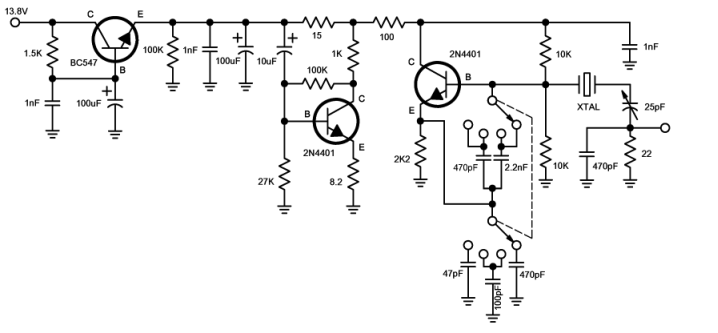
by SV3ORA
1-30MHz ultra low noise and distortion
crystal oscillator

by SV3ORA

This is a very high quality oscillator that can be made into a reference oscillator if combined with a crystal oven and followed by a source follower or emitter follower buffer amplifier.
The picture shows the schematic of the crystal oscillator, along with it's power supply. This type of oscillator has been discussed in detail with Charles Wenzel from Wenzel Associates in order to define it's performance. I have borrowed some of the text from his tech-lib page here. You could expect a phase noise better than -150dBc from this circuit and this is far better than any PLL can do. That is why I use a crystal oscillator and not any other kind of PLL/DDS. The trick is not to overload the crystal and thus degrade it's high-Q. The crystal used in that place, acts as a filter too, which helps eliminating some of the unwanted signals at the output of the oscillator.
The 25pF variable capacitor is used to shift the frequency of the crystal a few tens or hundreds of Hz in order to achieve fine tuning. Do not shift the crystal frequency too much or the phase noise will be degraded. Also, this capacitor affects the coupling of RF energy passed to the output. In lower capacitance values the coupling is minimum. Maybe a good idea (in order to achieve the same coupling at all values of the adjustable capacitor) would be to add another bigger fixer capacitor in parallel with the variable one, say a 500pF. Then the total combined capacitance will vary from 500pF to 525pF and this will affect only the frequency and not the coupling too much, but I have not tested it and I do not know what effect this could have to the phase noise of the oscillator.
I have performed different power and frequency measurements on the oscillator to understand it's power output versus frequency, but since this may be depend on the characteristics of the specific crystal used, I would not like to present the measurement results here. In general, the oscillator is more power-flat at 7-18MHz and presents higher output levels, whereas the power level is a bit reduced at the low and high ends of the shortwave bands (160m and 10m).
As far as concern the mechanical construction, use a two-pole four-position panel switch to switch between different bands. Use a panel mount crystal holder in order to change crystals for different bands. Try to keep the leads lengths as short as possible. Use a panel mount air variable capacitor, preferably silver plated, in order not to degrade the Q of the crystal too much. If you cannot find silver plated capacitors use aluminum or nickel plated, but always use air dielectric ones. Warning, both poles of the variable capacitor must be insulated from the chassis. Additionally, connect the capacitor such as the pole that you touch with your finger is connected at the 22 Ohm resistor side and not at the oscillator side! If you do it the other way, the oscillator frequency will change a bit every time you touch the capacitor with your finger. Even if you use an insulating knob for the capacitor, it is a good idea to connect it as I mentioned.
The power supply of the oscillator is composed of a BC547 transistor and a 2N4401. The BC547 section behaves like a capacitor multiplier, multiplying the 100uF at the base of the transistor with the 100uF shunt capacitor, to give a total of 10000uF. This should suppress any potential hum, but to achieve a lower phase noise oscillator I have added the 2N4401 section taken out from Wenzel Associates.
System designers often find themselves
battling power supply hum, noise, transients, and various perturbations wreaking
havoc with low noise amplifiers, oscillators, and other sensitive devices. Many
voltage regulators have excessive levels of output noise including voltage
spikes from switching circuits and high flicker noise levels from unfiltered
references. The traditional approach to reducing such noise products to
acceptable levels could be called the "brute force" approach - a large-value
inductor combined with a capacitor or a clean-up regulator inserted between the
noisy regulator and load. In either case, the clean-up circuit is handling the
entire load current in order to "get at" the noise. The approach of the 2N4401
circuit described here uses a bit of finesse to remove the undesired noise
without directly handling the supply's high current.
The key to understanding the "finesse" approach is to realize that the noise
voltage is many orders of magnitude below the regulated voltage, even when
integrated over a fairly wide bandwidth. For example, a 10 volt regulator might
exhibit 10 uV of noise in a 10 kHz bandwidth - six orders of magnitude below 10
volts. Naturally, the noise current that flows in a resistive load due to this
noise voltage is also six orders of magnitude below the DC. By adding a tiny
resistor, R, in series with the output of the regulator and assuming that a
circuit somehow manages to reduce the noise voltage at the load to zero, the
noise current from the regulator may be calculated as Vn/R. If the resistor is 1
ohm then, in this example, the noise current will be 10uV/1ohm = 10uA - a very
tiny current! If a current-sink can be designed to sink this amount of AC noise
current to ground at the load, no noise current will flow in the load. By
amplifying the noise with an inverting transconductance amplifier with the right
amount of gain, the required current sink may be realized. The required
transconductance is simply -1/R where R is the tiny series resistor.
The 2N4401 circuit is suitable for cleaning up the supply to a low current
device. A 15 ohm resistor is inserted in series with the regulator's output
giving a 150 millivolt drop when the load draws 10 mA - typical for a low-noise
preamplifier or oscillator circuit. The single transistor amplifier has an
emitter resistor which combines with the emitter diode's resistance to give a
value near 15 ohms. The regulator's noise voltage appears across this resistor
so the noise current is shunted to ground through the transistor's collector.
The noise reduction can be over 20dB without trimming the resistor values and
the intrinsic noise of the 2N4401 is only about 1 nanovolt per root-hertz.
Trimming the emitter resistor can achieve noise reduction greater than 40 dB.